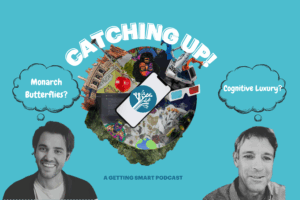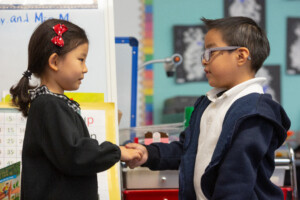Flipped Foreign Language

Moss Pike was raised in Las Vegas, studied Physics at Cornell University, and after a summer class in the classics found himself working on an M.A. in Classics at UCLA. He teaches Latin at the Harvard-Westlake School (HW), is the Middle School Dean of Faculty, and a regional leader in Greek and Latin linguistics and pedagogy.
Moss is working toward 1:1 implementation at his school but there is currently limited student access to WiFi. They use the Canvas LMS (called the Hub at HW) and Google Apps for Education (GAFE) with great success (Moss discusses selection here). Following is a recap of the innovative ways HW middle grades foreign language team is using technology.
Blogs are used in Latin classes to keep a nightly journal of reading notes. To help learn how to do critical reading of Latin texts, students keep track of notes on vocabulary, grammar, and style, in addition to brief summaries of plot. Once they become more comfortable with these reading skills, they use their blogs to answer larger literary questions about narratology, comparative mythology, history, etc. Last week, they compared the characterization of Venus in the Cupid and Psyche myth to the Homeric Hymn to Aphrodite in a blog post. After completion, they’ll be asked to read and comment on each other’s work, which helps them with their critical reading skills, and they’ll revisit these posts when they meet Venus in the Aeneid. (More from Moss on Digital Storytelling and Narratology.)
Digital storytelling is done, with variations, in each of the 4 language programs. Generally, students record and edit video with any method familiar to them (e.g. using a smartphone, tablet, YouTube, iMovie/MovieMaker, etc.). The videos ask students to tell a story, compose a dialogue, record a song, write a commercial, etc. in the target language. In various language classes, students also create digital storybooks using PowerPoint and Keynote, or web-based tools such as Prezi, Storybird and Glogster. (Here is a longer list of tools the department has collected.)
In the past, video files were emailed to teachers, which was problematic. Now, videos are either uploaded to the Hub or a link to a video stored on a cloud server (e.g. HW YouTube or personal YouTube account) is submitted using the Hub or a Google Form, which easily collects all the students video URLs.
Google apps have increased the amount of collaboration in every language program. For example, the Latin program uses shared Google Spreadsheets to build running lists of vocabulary and grammar notes that can then be used in subsequent levels. Students in every language use Google Docs for collaborative projects. Google Books are used in Latin to access out-of-print textbooks and other grammar resources like prose composition manuals. Students can access them for free.
Peer-reviewed discussion is done in Latin and Spanish within the Hub. Teachers give instructions for posting in the target language (e.g. short sentences using new grammar or vocabulary) or pose written questions in the target language, and students submit replies in the discussion forum. Once completed, the Hub can match students for “peer review”, who will then comment on each other’s work. Optionally, teachers can create a rubric for students to follow when evaluating each other.
QR Codes have been used in French and Latin, as well as on posters publicizing department-led study abroad trips for students of Spanish. Moss taught a Latin “mini course” in the fall, in which he gave students QR codes linking to a document that would help students translate the Latin they worked on together in the class. (More information on the mini-course can be read here).
Quizlet (for Latin) and other online flashcard tools, like Conjugemos.com (Spanish program) are used to build and review vocabulary. Students can access materials on any device. Additionally, the Latin program keeps a running list of “To Know” vocabulary in a Google Spreadsheet that students can cut-paste into Quizlet.
Video/voice recording is done using the Hub and other tools like VoiceThread primarily by the Chinese and Spanish programs. Students can either interact with the teacher or with their peers. In one type of exchange, teachers will record a short video or audio clip as a new discussion post, to which students must respond with their own video or audio directly in the Hub. Teachers can then review responses, as can other students, and give feedback directly to students. In another type of exchange, students will pose questions directly to peers using a video or audio post within a discussion thread, and their assigned partner–often in another class section–will post his/her audio or video response to those questions.
Podcasts in the target language are shared with students in some language courses to increase their exposure to native use of the language, as well as to current events abroad.
A number of students who own iPhones have downloaded the Canvas for iOS app in order to easily submit text, audio and video responses to discussion threads from their iPhones.
YouTube is used frequently in the Chinese, French and Spanish programs to introduce current events, music and art to students. For example, students saw YouTube video footage from the ARCO Madrid Feria Internacional de Arte Contemporáneo while the fair was still taking place earlier this month.
Spotify is used primarily in the Spanish program to share world music with students both in the classroom and via shared playlists; students can also access this music for free using a home or lab computer.
Future Directions. Next year, the middle school will be fully wired and 7th graders will all bring laptops to school. As a result, they will be able to do more in-class tech-supported activities around technology, including expanding on the ideas listed above. Blogs can be used to a greater extent by giving more in-class writing assignments, creating more opportunities for out-of-class peer responses. Chatrooms can be used for in-class discussions. Google docs will be used more fully for note taking and collaborative creation.
Teachers will be able to give interactive assessments that include audio and/or video and feature more projects and inquiry-based tasks. Quizzes can be made in Google Forms, which can then be automatically corrected by using simple JavaScript code (e.g., free Flubaroo script) to be run on the form date, once all students have finished. Submissions and answers can be automatically emailed to students, using custom Google apps scripts.
Google Art Project, Google Earth, and Google World Wonders Project have all been used in Latin classes though only passively. Google Search’s ability to search by image allows us to create a “digital” scavenger hunt. Once students have their own devices these tools more creatively.
Twitter is currently used in French, Spanish, and Latin to an extent, with feeds used for specific courses or clubs. Next year, they’d like to take use of Twitter further and have students create feeds to use to share ideas, pictures, links, etc. with classmates. They are also considering incorporating Tumblr and Instagram, as they are great sources of images from museums and from photographic competitions and collaborations around the world (for example, @mextagram).
Math has received much of the early attention in the personalized learning revolution. Language acquisition is bound to get more attention in the next few years. Moss and his colleagues are early adopters worth watching.
For more, see the list of reviewed language learning tools from Edsurge.
Thanks to Moss Pike for providing the details and examples for this post.








Joy
Thanks for sharing these tools. I also wish to leave a link that may be useful for your language learning journey. You may find native tutor or online language teacher in this site. Here's the link: https://www.justlearn.com/